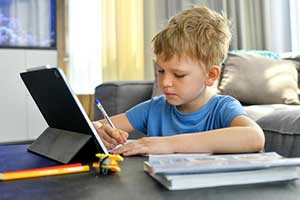Blended learning combines technology with traditional face-to-face instruction to leverage the best of both worlds. This approach to education has become increasingly popular in recent years due to its versatility and effectiveness. Before blended learning can be implemented in a classroom, it is important to consider what blended learning method is best suited for the particular environment, how to personalize teaching methods, and what resources can help enhance the student’s learning experience.
3 Ways To Implement Blended Learning In Your Classroom
Educators interested in implementing blended learning in their classrooms can do so in a few different ways. Technology has become more prevalent in the lives of learners over the last decade. Today, educators have the opportunity to implement technology into their everyday lessons by using information, tools, and resources that are readily available online. Although many different blended learning methods exist, the most commonly used methods include the flex model, the flipped classroom model, and the station rotation model.
Flex Model
The flex model of blended learning is often favored in schools that support a large number of at-risk or non-traditional students. With the flex model approach, learning materials are generally delivered over the Internet. Learning is majorly self-guided and students are encouraged to learn independently and practice new concepts in a digital environment. Although the flex model is one of the more popular methods used in schools that need to address students with academic, behavioral, or socio-economic challenges, it has been shown to be effective within almost all educational institutions.

Flipped Classroom Model
The flipped classroom model essentially flips the traditional relationship between classroom time and homework. In a flipped classroom environment, students learn with online lectures and coursework.
In-person class time is used for teacher-guided projects or practice. When students are introduced to content at home, they can work through the coursework in a school environment supported by a teacher and peers. The main goal of the flipped classroom model is to maximize a student’s potential by adhering to their social habits.
Station Rotation Model
The station rotation blended learning model allows students to rotate through a series of stations on a fixed schedule. At least one of these stations is usually an online learning station. The station rotation model is used in all school environments but is most common in elementary schools where rotating stations or centers are already a familiar concept. Under the station rotation model, students can complete all of the learning activities on the same schedule, usually when promoted by a teacher or the clock. This model is similar to the lab rotation model in which students rotate on a fixed schedule to a computer lab.
Personalize Teaching Methods For Each Student
Every student is unique in the way that they learn and ingest information. This means that not every blended learning model may be right for every student. It is important to consider the students’ various needs in a classroom and personalize their learning experiences to meet their individual needs. Students in every model should be provided with a diverse amount of resources and tools. Personalizing teaching methods enables students to work at their own pace and ability level. By personalizing teaching methods for each student, educators are better equipped to help students become more confident in their abilities.
Use Online Educational Games
Game-based learning has become a go-to instructional method in modern classrooms. The use of online educational games provides students with the opportunity to master basic curriculum and enhances problem-solving and critical thinking skills. Today, most educators employ some form of game-based learning in their blended learning environment as games have the power to explain, explore and reinforce learning materials. Online educational games can be played independently outside of the classroom or during regular class time. Online educational games also promote collaboration and friendly competition in some instances, as students can compete against one another.
Start Implementing Blended Learning With Legends of Learning!
Implementing a blended learning model in a classroom can help personalize student learning and boost motivation. The teacher and student can collaborate and educators can more easily access each student’s unique needs and learning style. Through blended learning, students can benefit from face-to-face instruction and the use of technology to have more control over their time and pace.
When online educational games are introduced into a blended learning model, both educators and students can thrive. For more information about implementing blended learning or searching online educational games, create a free account on Legends of Learning.



